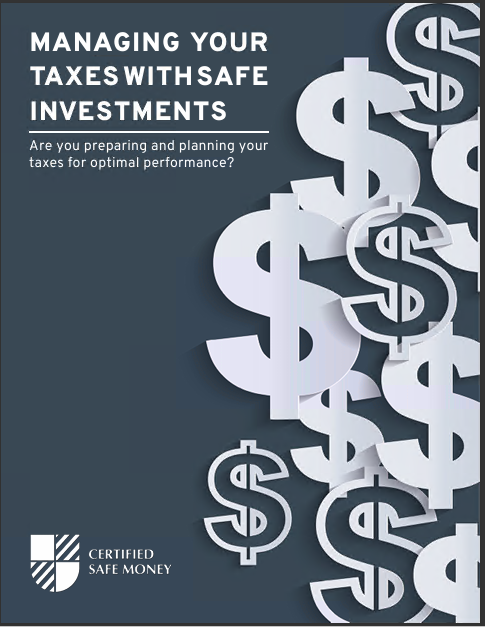Key Takeaways
-
Taxes can significantly reduce your long-term annuity income, sometimes by tens of thousands of dollars over your lifetime.
-
Understanding how different annuity types are taxed helps you create a clearer retirement income strategy and avoid unexpected tax burdens.
Why Taxes Are a Central Factor in Annuity Planning
When you purchase an annuity, your focus is often on the guarantee of steady income for retirement. However, what many people underestimate is the role of taxes in shaping the actual income you will take home. While annuities are considered safe money investment options, their tax treatment can dramatically affect the real value of your payouts. If you plan to rely on an annuity for income in retirement, you need to consider not only how much it pays but also how much you keep after taxes.
In 2025, with tax laws still shaping retirement outcomes, understanding this connection between annuities and taxation has become critical. This article will walk you through the different ways taxes affect annuity income, how tax-deferred growth plays out, the impact of withdrawals, and strategies to reduce the lifetime tax burden.
1. The Tax-Deferred Growth Advantage and Its Future Implications
One of the most attractive features of annuities is tax-deferred growth. This means you do not pay taxes on the earnings each year while your funds remain in the annuity. Instead, taxes apply when you start withdrawing money.
-
Immediate benefit: Deferring taxes allows your funds to compound faster compared to taxable investments.
-
Future obligation: Eventually, taxes must be paid. The deferral may result in a larger tax bill later when withdrawals begin.
By the time you reach retirement, your tax bracket may or may not be lower than during your working years. If it is not lower, the benefit of deferral could be outweighed by higher taxes in retirement.
2. Ordinary Income Tax Rates on Annuity Withdrawals
Withdrawals from annuities purchased with pre-tax dollars, such as through retirement accounts, are taxed as ordinary income. This means the distribution is added to your taxable income for the year and taxed at your marginal rate.
For someone who holds significant annuity income, this can push total income into higher brackets, raising the overall tax burden. Since ordinary income tax rates differ from long-term capital gains rates, annuity income may be taxed at a higher level than certain other investments.
3. The Role of Non-Qualified Annuities
If you buy an annuity with after-tax dollars (non-qualified annuity), the tax treatment changes. Your principal, or the amount you initially invested, is not taxed again. However, the earnings portion of withdrawals is still subject to ordinary income tax.
-
Exclusion ratio: When you receive periodic payments, a portion is considered a return of your principal (non-taxable), while the remainder is taxable earnings.
-
Shift over time: Once the principal has been fully returned, all subsequent payments are fully taxable.
This mixture can create different tax burdens at different stages of retirement, which makes careful planning necessary.
4. Lifetime Impact of Taxation on Annuity Income
It is important to project the cumulative effect of taxes on your annuity over decades. Even modest tax rates, applied consistently over 20 or 30 years, can substantially reduce the total amount you retain.
For example:
-
A steady annuity payout taxed at 22% annually over 25 years could reduce lifetime income by hundreds of thousands of dollars compared to the gross amount received.
-
If tax laws change during your retirement, the impact can be even greater.
Understanding this compounding effect of taxation is essential to accurately calculate your real income potential.
5. Required Minimum Distributions (RMDs) and Their Effect
If your annuity is held within a qualified retirement account, such as an IRA, you must begin required minimum distributions (RMDs) starting at age 73 under current rules. These withdrawals are fully taxable.
-
Timing issue: Even if you do not need the income, you must withdraw it.
-
Tax issue: RMDs can push your taxable income higher than planned, especially if you have other income sources like Social Security or pensions.
This rule ensures that the tax deferral on retirement savings eventually ends, forcing you to pay taxes on the funds.
6. Early Withdrawals and Penalties
If you withdraw from your annuity before age 59½, the IRS imposes a 10% penalty on top of regular income tax. This penalty can make early withdrawals especially costly and drastically reduce the net amount you retain.
Therefore, annuities are best suited for long-term retirement planning, not for short-term liquidity needs.
7. State Taxes and Local Considerations
In addition to federal taxes, some states tax annuity income. This adds another layer of complexity and can reduce the after-tax value of your annuity significantly, depending on where you live.
For example:
-
Some states exempt retirement income partially or entirely.
-
Others apply the full state income tax rate.
Before committing to an annuity, you should account for the state in which you plan to retire, as relocation later in life may change your tax burden.
8. The Impact on Social Security Benefits
Your annuity income can also indirectly affect how much tax you pay on your Social Security benefits. The IRS uses a formula based on your combined income, which includes half of your Social Security benefits plus all other taxable income, such as annuity payouts.
-
If your combined income exceeds certain thresholds, up to 85% of your Social Security benefits may become taxable.
-
This creates a chain reaction where annuity income not only gets taxed itself but also increases taxes on another critical income source.
9. Inflation and Tax Brackets Over Time
Tax brackets are adjusted periodically, but not always in a way that fully accounts for inflation. This creates the risk of bracket creep, where inflation pushes you into higher tax brackets even if your purchasing power remains the same.
If your annuity provides level payments that do not increase with inflation, the real value of your income shrinks, while the nominal amount may still push you into higher brackets. This mismatch underscores why tax planning must go hand in hand with inflation considerations.
10. Strategies to Reduce the Tax Burden
While taxes are unavoidable, there are strategies you can use to manage their impact on your annuity income:
-
Diversify income sources: Balance annuity payouts with other assets that receive favorable tax treatment, such as Roth accounts.
-
Time withdrawals carefully: Coordinate annuity income with other distributions to avoid pushing yourself into higher brackets unnecessarily.
-
Consider partial annuitization: Instead of annuitizing your entire balance, you can annuitize only part, leaving flexibility with other funds.
-
Leverage tax-efficient accounts: Holding annuities outside of qualified accounts may provide more flexibility in managing taxable income.
11. Planning Across Different Time Horizons
Your tax strategy should adjust as your retirement timeline progresses:
-
Pre-retirement (50s to early 60s): Avoid early withdrawals to prevent penalties. Focus on building annuities with tax-deferred growth.
-
Early retirement (60s to early 70s): Plan withdrawals to stay in favorable tax brackets before RMDs begin.
-
Post-73: Manage RMDs carefully, possibly by coordinating with other taxable events to minimize bracket increases.
This staged approach helps reduce cumulative taxes over decades.
12. Why Professional Guidance Matters
Tax laws are complex and frequently change. While general strategies are useful, personal factors such as your health, expected lifespan, total retirement assets, and state of residence make a huge difference in how taxation affects you.
Working with a licensed professional ensures that your annuity and retirement strategy accounts for the most current laws and the nuances of your financial situation.
Taking Control of Your Retirement Income Strategy
Your annuity is meant to provide reliable income, but taxes play a decisive role in how much of that income you actually keep. By understanding how annuities are taxed, how withdrawals affect your taxable income, and how different strategies can help reduce lifetime taxes, you gain control over your financial security.
This is the moment to think long term. Do not let taxes silently erode your retirement income. Get in touch with a licensed professional listed on this website for advice tailored to your situation.












